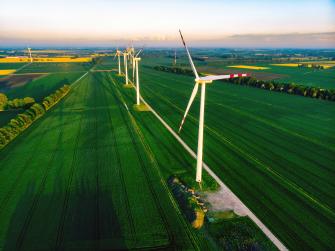Some countries are prepared for a green future. Others are the United States and Australia
MIT ranks countries in its latest Green Future Index. Environmental Defense Fund’s Jill Duggan explains why Europe continues to lead the way.
Over the last two decades Europe has forged ahead with tackling climate change – with some acknowledged successes and a few missteps along the way. Even so, its dominance in the Green Future Index 2022 was eye-catching.
In all categories, the actions European countries have taken both collectively and individually pushed them into 16 of the top 20 spots in the MIT index of 76 nations and their economies.
So is this cause to toast Europe’s global warming laurels, or roll up its collective climate-fighting sleeves even higher? Both, really, with a well-deserved dose of optimism, according to Jill Duggan, the Executive Director of Environmental Defense Fund-Europe.
“You have got to be an optimist to work on tackling climate otherwise we’d give up and go home, wouldn't we?” Duggan said. “But I do think seeing the result of hard-won European action, validates the effort.”

The index measured how countries are cutting CO2 emissions and developing clean energy and innovation, along with looking at environmental protections and climate policies. The research broke its findings into four color-coded categories with some curious results. The U.S. and Australia are notable by their absence from the top tier.
“What you can take from this chart is that the countries that are best placed for a green future are not the poorest countries in the world. There’s a lot of the G7 countries that have gone further. And many of those European countries do see a role in setting an example and influencing the world in a way others might not,” Duggan said.
That overarching European Union collaboration has underpinned success with, for example, key legislation that set up the European carbon market nearly 20 years ago and set targets for renewable energy and transportation emissions when many countries were still denying the climate science. These countries discovered, fairly early on, that there are real economic benefits in taking action to address climate change.
“Preparing for a green future didn’t damage their economic growth. Many of these countries would say it’s probably enhanced their economic growth,” Duggan said. “This is about opportunity, building sustainable jobs, building greater resilience, and other benefits like cleaner air, quieter cities, and all of those nice things that just come as little bonuses when you really address the energy transition.”
Of the 16 countries, four – Norway, France, Belgium and Ireland – actually dropped spots from last year, averaging a 3.5-place fall, but still remained among the top 12. Three – No. 1 Iceland, No. 2 Denmark and No. 6 Finland – stayed steady at the same ranking from a year ago.
Poland made the biggest leap of the other nine countries, rising 18 spots to No. 16. Those green-gaining leaders averaged nearly an 8-spot jump compared to last year.
“It’s a snapshot,” Duggan said. “But to have 16 of the top 20 coming from Europe shows they really are doing something right, and that is they are consistently going for it and learning from their mistakes and operating as a bloc on this issue for the last 20 years.”
Europe’s leadership role in forging a greener future has long been acknowledged and continues to be lauded as the climate crisis ramps up.
On April 18, an opinion piece in The New York Times offered this analysis: “In almost every aspect of the industrial economy — from making steel and cement to new aircraft to better systems for heating homes and making electricity — the emission reduction plans in Europe are opening markets to new technology while convincing big existing businesses, like oil and gas companies, that they must innovate or get out of the way.”
The Green Future Index authors were clear in noting the rankings were completed before Putin’s invasion of Ukraine in late February, and that the conflict “is likely to have far-reaching and ongoing implications for the sustainability efforts of countries all around the world.
So far, it appears to have created a sense of urgency in Europe to accelerate climate policies and clean energy transitions.
“The war in Ukraine is encouraging many to make sure we have greater energy security,” Duggan said. “One of the things that renewable resources can give us is greater energy security. They are reliant on the sun and wind, but not on other states with political objectives.”
Countries are reliant on strong economies, though, a common thread throughout the top 20. It’s not a coincidence that the United Kingdom (4th), France (7th), Germany (8th) and Italy (17th) are members of the G7. Wealth certainly helps, as nations look to diversify energy supply, reduce demand and transition faster into a cleaner and greener future. But it’s no guarantee, as lacking the political will, the United States (21st) and Australia (52nd) have yet to crack the top tier.
But rankings and data also present a chance to help other European countries. Duggan points to Slovakia at No. 46 and Romania at No. 47 as examples of where climate strategy gains could be made.
“It matters having well-developed civil society groups and non-government organization communities. The work of EDF can be really, really important in helping countries with those things and getting into that top tier,” Duggan said.










